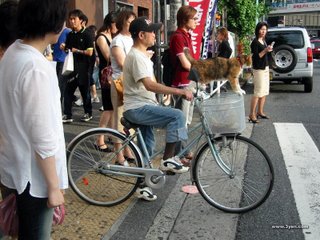Slow cycling

A cat sharing its space with its cyclist and other road users.
( You can click on these pictures to enlarge them ).
The major point of difference between the cycling cultures in Japan and New Zealand is that the pace at which cyclists habitually move in Japan is considerably slower than that at which cyclists expect they should travel in New Zealand.
The attitudinal and behavioural differences between the (active) cycling cultures may be the reasons why different cycling technologies and practices prevail in each country.
The lack of uptake of utility cycling in New Zealand may be due to some extent to a reluctance among active cyclists here to recognise the needs of (would be) slower cyclists.
While most cycle-activism in New Zealand is being done by and on behalf of the interests of athletic high-speed cyclists for whom cycling is also a recreational activity, the interests of our ‘would-be’ cyclists (like those who make up the majority of urban cyclists in Japan who just want to get around at a relaxed pace) are being completely neglected.
Nobody is working for the interests of the 'would be' cyclists.
It is from this section of society that the greatest increases in those taking up 'utility' cycling could be expected to come. e.g. the elderly and everyone who lives in the inner suburbs.
Utility cycling is not a race: As long as cycle action groups, local governments, bicycle retailers and roading authorities refuse to take into consideration the needs of ‘slow’ cyclists, ‘utility’ cycling will remain what it is today: 2% of all urban traffic.


1 Comments:
A cycle lane can accomodate both slow or utility cyclists and the faster cyclists.
Post a Comment
<< Home